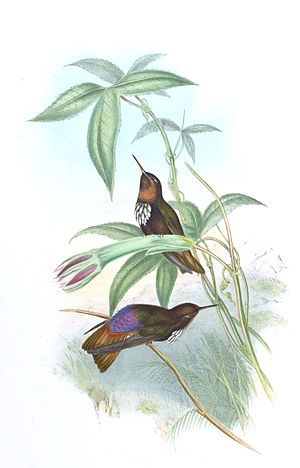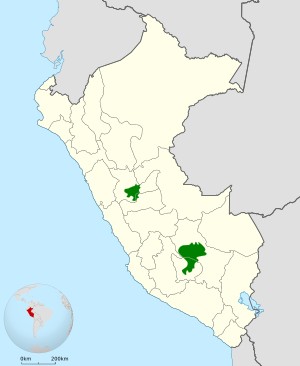White-tufted sunbeam facts for kids
Quick facts for kids White-tufted sunbeam |
|
|---|---|
 |
|
| Painting by John Gould, for A Monograph of the Trochilidae (Family of Hummingbirds) | |
| Conservation status | |
| Scientific classification | |
| Genus: |
Aglaeactis
|
| Species: |
castelnaudii
|
 |
|
The white-tufted sunbeam (scientific name: Aglaeactis castelnaudii) is a beautiful type of hummingbird. These tiny, fast-flying birds belong to the Trochilidae family. You can only find them living in the country of Peru, in South America. They love to live in warm, wet montane forests (forests on mountains) and high-up shrublands.
Contents
What Does It Look Like?
An adult white-tufted sunbeam is about 12 centimeters (almost 5 inches) tall. It weighs around 7 to 8.5 grams, which is about as much as two pennies! This hummingbird has a straight, black beak. It also has a special patch of white feathers right under its chin, on its chest. This is how it gets its name!
The rest of its body is usually a dull brown or dark color. When it flies or hovers, you might see shiny, rainbow-like feathers on its back. These feathers shimmer in the light.
Differences Between Males and Females
Male and female white-tufted sunbeams look very similar. However, there are a few small differences.
Males have a dark, brownish-black color on their upper backs. Their lower backs and rumps (the area above their tail) can have a pretty magenta (pinkish-purple) shine. Their tails are forked, like a "V" shape. The belly, sides, and neck of a male are a dull brown. Their throat and chest band are blackish. Of course, they have the special white feather tuft on their chest.
Females look a lot like males. But their backs are not as shiny or iridescent. They also have a smaller fork in their tail.
Young White-Tufted Sunbeams
Young white-tufted sunbeams, called juveniles, look a bit different. Their feathers are more evenly brown all over. They do not have the shiny, iridescent feathers that the adult birds have.
Where Do They Live?
The white-tufted sunbeam lives in a small area of Peru. This area is broken up into many smaller pieces. Scientists believe the total area they live in is about 832 square kilometers (about 321 square miles). This number is based on how much tree area is left in their habitat.
These hummingbirds live in two main parts of Central and Southern-Central Peru. They like drier parts of evergreen mountain forests. They also live in valleys between mountains and open shrub areas.
White-tufted sunbeams often perch right at the very top of trees. However, in places where they share their home with another type of hummingbird called the Shining sunbeam (Aglaeactis cupripennis), they act differently. In those areas, white-tufted sunbeams often hide on lower branches or in thick plants.
What Sounds Do They Make?
Like many hummingbirds, the white-tufted sunbeam has a very soft and quiet call. You might not even notice it!
They make a repeated "tzit" sound. When they are chasing other birds, they make a series of "titi-tsreet-tsreet-tsreet" sounds. This louder sound is only used when they are in a fight or feeling threatened. They can also make a thin, high-pitched "seeeuuu" noise.
What Do They Eat?
The main foods for the white-tufted sunbeam are flower nectar and insects. Nectar gives them energy, and insects give them protein.
They get nectar from many different types of flowering plants. Some of these plants include:
- Barnadesia
- Berberis
- Brachyotum
- Centropogon
- Labiatae
- Lupinus
- Salpichroa
- Siphocamplos
White-tufted sunbeams are known for how they feed. They always hold onto the flowers while they drink nectar. They are also very good at catching insects while flying in the air!
Is This Bird in Danger?
The white-tufted sunbeam's home is broken into many small pieces. Because of this, the International Union for Conservation of Nature (IUCN) has listed it as "near threatened." This means it could become endangered in the future if things don't change.
Even though researchers agree that the number of these hummingbirds is going down, the IUCN does not call it "vulnerable." This is because its habitat is not considered "severely fragmented" enough for that label.
We don't know exactly how many white-tufted sunbeams there are. But people who study them say they are "common but patchily distributed." This means you can find them in many places, but only in small groups. The biggest reason their population is shrinking is because they are losing their homes. This happens due to deforestation, which is when forests are cut down.
See also
 In Spanish: Aglaeactis castelnaudii para niños
In Spanish: Aglaeactis castelnaudii para niños


